

- Musikwissenschaft-
liche Analysen - Sullivans Ivanhoe –
Oper und lit. Vorlage - Longfellow, Liszt
and Sullivan - Sullivas religious style Festival Te Deum
- Arthur Sullivan und
die englische Oper - Sullivas religious style Festival Te Deum
- Sullivan's King Arthur
- Sullivan's ballet Victoria and Merrie England
- Sullivan's ballet L'Ile Enchantée
- Forschungsarbeiten
- Vorträge
- Archive
- Quellenkritische
Editionen - Spurensuche
- Aufführungsmaterial
Rhythm and Text Setting in The Mikado
Rhythm and Text Setting in „The Mikado“
by Robert Fink
(with kind permission of the author; first published in 19th Century Music, vol. XIV No. 1 summer 1990)
And to your humours changing,
I tune my supple song. –
The Mikado, act I
I
Unlike Jacques Offenbach and Johann Strauss, Jr., Arthur Sullivan did not begin his career as a composer of light music, and even at the zenith of Gilbert and Sullivan mania he never dedicated himself entirely to the popular. If there were „two cultures“ of music in the nineteenth century– the künstlich and the trivial– Sullivan was one of the rare musicians who made a deliberate artistic choice to wander freely between them. This was a choice not available to the newly specialized craftsmen who furnished the century with reams of dance music and operetta, and not thinkable as a rule to serious art-music composers– in whose company Sullivan began and certainly aspired to finish. From childhood on, Arthur Sullivan was seen by many British musicians as the great hope of English music. His admirers hailed him as „the English Mozart“ ; later, some of the same critics would denigrate him as „the English Offenbach.“ Perhaps a more accurate and useful comparison would be to see Sullivan as heir apparent to the position of „English Mendelssohn“ ; certainly his early life and training were as promisingly high-minded as that other child prodigy so beloved by the English.1
Like Mendelssohn, Sullivan sang as a trained boy soprano. He was accepted into the Chapel Royal in 1852, beginning a lifelong association with the vocal music of England's past masters, both sacred and secular. Under Canon Thomas Helmore, the boys sang not only at St. James's but also carried the soprano lines in London's aristocratic Madrigal Society.2 It is not surprising that Sullivan's operas are filled with the sound of unaccompanied voices: disguised church anthems mingle with imitation „madrigals“ and „glees.“ „See How the Fates Their Gifts Allot“ from The Mikado is a particularly painstaking recreation. Gilbert's text adopts the glee's characteristic lofty philosophic tone and didactic bent – even though its actual content is pointedly amoral– and Sullivan perfectly mimics the denatured Handelian style so beloved of eighteenth-century singing societies.3 Sullivan's engagement with seventeenth- and eighteenth-century words and music goes beyond mere pastiche, however; his attitude toward text setting is in many ways atypical of nineteenth-century England – closer to The Indian Queen than The Lily of Kilarney.
At the age of fourteen, Sullivan was chosen as the first recipient of the newly created Felix Mendelssohn scholarship at the Royal Academy of Music. Two years later the administrators of the scholarship, impressed with his progress, provided funds for study at the Konservatorium in Leipzig, whose brilliant faculty at that time included Moscheles (piano), Hauptmann (composition), and David (violin, conducting). Young Arthur, championed by such patrons as the recently retired Jenny Lind, Sir George Smart, and piano manufacturer Henry Broadwood, was clearly being groomed for a brilliant career as a composer of serious music. His stay in this bastion of German musical culture (1858-61) was to be a crucially formative experience.
Incidental music to Shakespeare's Tempest, composed by the nineteen-year-old Sullivan as a „graduation piece“ for Leipzig, shows that he had learned his intended lessons well. The suite is firmly in the German Romantic tradition, showing the strong influence of Beethoven, Mendelssohn, and particularly Schumann. There are even traces of Wagner and Liszt, as ex. 1, a rhapsodic, recitativelike passage for soli violins, demonstrates. It is completely unaccompanied save for ambiguous diminished-seventh chords at the beginning and end.

Thus, Arthur Sullivan in 1861: a composer with immense natural talent, impeccable artistic training, and the active support of Britain's major musical figures. But sometime in the mid-1870s Sullivan let the mantle of Mendelssohn slip off his shoulders and in the company of humorists such as F. C. Burnand (editor of Punch) and W. S. Gilbert, picked up the motley cloak of Offenbach – much to the dismay of the serious-minded. Today we can accept and seek to probe the immense stylistic gulf between the expectations raised by the Tempest music and the actuality of Sullivan's comic-opera style in 1885. A contemporary critic, however, could only register “a sense of disappointment at the downward art course that Sullivan appears to be drifting into. . . [He] has all the ability to make him a great composer, but he wilfully throws his opportunity away. A giant may play at times, but Mr. Sullivan is always playing.”4
Why and how a composer with Sullivan's early prospects found himself by 1886 immensely famous, financially independent, and socially lionized for composing drawing room ballads, hymns, and operettas, which the entire music establishment concurred in considering „beneath“ him, is understandable largely as a result of the complex and paradoxical relation of musical values and emerging mass culture in the nineteenth century – a relation that falls more under the purview of music sociology than the analytic viewpoint of this study.
In any case, having decided to compose popular light operas, Sullivan, unlike Offenbach, also had to decide upon a new musical style. The dry, harmonically conservative, classicizing comic style that Sullivan developed for his Savoy operas – quite different from his „serious“ style – was by no means the automatic approach for a composer in this artistic position. When the Wagner protege Peter Cornelius came to write Der Barbier von Bagdad (an Arabian farce as riotously frivolous in tone as any operetta), the rich, chromatic result was scarcely distinguishable from his serious style – or that of any late nineteenth-century operatic epic. Humperdinck's Hänsel und Gretel cloaks a naive children's tale in the rich language of the Wagnerian music drama. Even Sullivan's own competitors and imitators, composers such as Frederic Clay and Alfred Cellier, wrote in a comic style that harmonically at least, is often more up to date than that which reigned at the Savoy.5
Why then does The Mikado sound so old-fashioned and unromantic – not just in comparison with Parsifal, which actually predates it by three years, or Die Meistersinger, which Sullivan deeply admired (“ [it is] not only Wagner's masterpiece, but the greatest comic opera that was ever written“ ),6 but even next to Sullivan's own contemporaneous serious project, The Golden Legend? Cynics (or sociologists) may seek an explanation of Sullivan's anachronistic idiom in the exigencies of the English markt-place, and there is no question that the success of his Savoy operas allowed the composer a life-style completely unattainable in England by even the most critically acclaimed symphonic composer. Still, a historian with a sympathetic eye will discern more at stake here than just a good business sense. To find the historical roots of Sullivan's style, and to begin to account for his unique rhythmic relation to Gilbert's text; one must digress and outline a musico-poetic struggle that dates back to the seventeenth-century beginnings of opera in England.7
II
One of the impulses behind the creation of opera was a concerted attempt to increase the expressive power – and intellectual respectability – of music by ruthlessly subjugating its rhythm to that of poetry. The invention of recitative was the most radical and successful experiment in this direction; unfortunately for measured music, the accentual patterns of most vernacular poetry (unlike the quantitative meters of Latin) are so simple and regular that they cannot be translated directly into music without severe limitations on compositional invention. On the continent, operatic composers soon broke free. A distinct and honorable subspecies of poet arose: the professional librettist, who was honored less for flights of pure genius than for his artisan's skill in creating verse that lent itself to musical setting.
In England, however, poets never accommodated themselves to the increasingly independent growth of music. Augustan poets such as Swift and Dryden consistently derided music as foreign and effeminate, demanding that composers like Purcell „humour [their] invention„8 rather than they the composers'. English musical theater became an affair whose twisted growth consistently avoided the complex relation of word and tone. It either ignored the English language, as foreign regimes ruled the major opera houses – or gleefully dispensed with original music altogether in ballad opera, parodistically exploiting the comic possibilities of allowing „doggerel rhymers“ to fit their texts to preexistent music. The chance for a native, truly English opera was lost.
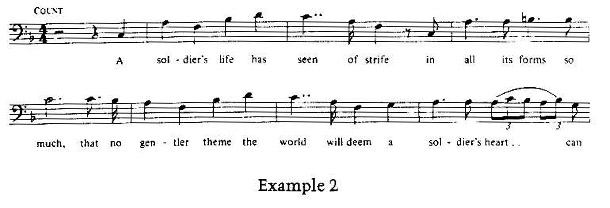
Sullivan had to develop his theatrical style in the absence of any flourishing tradition, and it is highly significant that his text setting is vastly more sensitive than that of his continental contemporaries – or his benighted English predecessors. The main obstacle to the revival of the Italianate operas of nineteenth-century English composers such as Michael Balfe [The Bohemian Girl, 1843), Vincent Wallace (Montana, 1845), and Julius Benedict [The Lily of Kilarney, 1862) is not any egregious lack of quality; the obstacle is precisely the feature that should give them precedence for English-speakers: the fact that they use our language. Or, rather, grotesquely misuse it. An example from Balfe's The Bohemian Girl is sadly typical in its amazingly indifferent treatment of (admittedly insipid) words (ex. 2). The problem is not really Balfe's reliance on Donizettian march rhythms, so unsuited to the rhythm of English speech – that might be accepted as an inevitable result of an Italianized composer's response to the text's military references. What is truly deadly is the end of Balfe's first phrase, whose tonicizing rise to an accented C# clumsily flaunts the weakest moment of the poetry: an awkward syntactical inversion that allows „so much“ to end rhyme with „touch,“ but destroys any naturalness and intelligibility in the verse. Although Sullivan rarely had to deal with poetry this poor from Gilbert, he was never guilty of such a crucial failure of rhythmic imagination. Balfe clearly had ceased to care at all what the poetry sounded like, either with or without music.
Sullivan's operatic style attempts to create for itself a uniquely English text-music synthesis lost in the bitter intramural struggles of seventeenth- and eighteenth-century British theater. Gilbert, the literary descendant (if not the poetic equal) of irascible satirists like Dryden, Pope, and Swift, was treated with the deference and care that they had been at such pains to demand. But the relation runs deeper: it is the spiritual affinity between the satiric style of Gilbert and that of the Augustan poets that gives the key to comprehending Sullivan's conservative choice of harmonic and periodic idiom. James Winn's summary formulation is worth quoting at length: “The Romantic poets loosened their syntax in the name of a more „musical“ poetry, a stylistic change which made their poetry less, not more, like the music of their contemporaries the Viennese classical composers, arguably the most syntactical music in Western history. In its capacity to resolve ambiguities with a punning wit, in its essentially comic style, the music of Haydn and Mozart was much more analogous to the poetry of the Augustans. But the Augustans, deaf to the growing tonal logic of the music of their time, had pilloried music for its ambiguity, its fluidity, its „femininity“ . . . . Finally, however, the Romantic literary myth about music affected music itself, and when it did, the resulting music came to cherish and prolong harmonic ambiguity.9
The music that „cherishes and prolongs harmonic ambiguity“ is that same German Romantic music which Sullivan was able to produce with such youthful panache in his music for The Tempest; he must have sensed, perhaps unconsciously, that only by adopting a more conservative idiom could he achieve the clarity to match Gilbert's finely honed wit with musical wit of his own. Some negative evidence supports this conclusion. In Patience (1881), Gilbert's literary satire poked fun at the excesses of the „Aesthetic“ movement, epitomized by the antics of ultraromantic, decadent poets like Oscar Wilde and Algernon Swinburne. Sullivan provided the perfect musical accompaniment for the pre-Raphaelite effusions of his arch literary heroes by allowing his music to relax into a parodistically aimless and „romantic“ chro-maticism (ex. 3). These „purple passages“ correspond exactly to the hilarious fustian that Gilbert has his poetic poseurs speak. They sound even more ridiculous when juxtaposed with the healthy diatonicism of Patience, the pretty but incurably prosaic milkmaid (ex. 4).
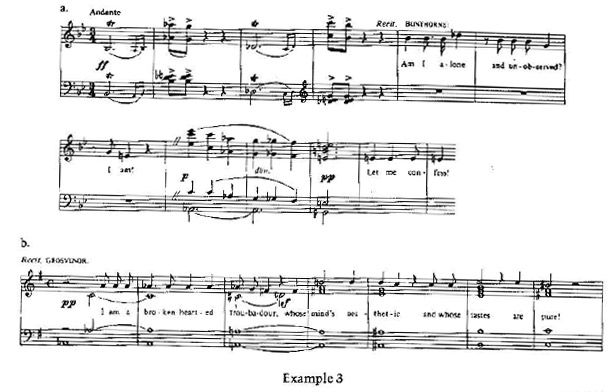
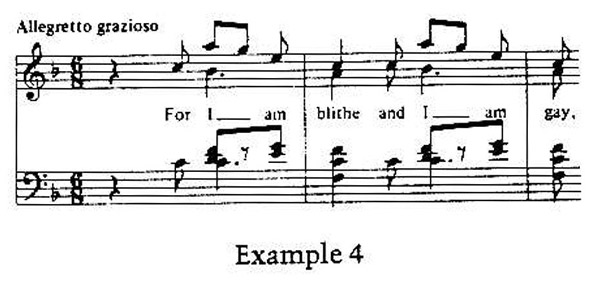
III
The most illuminating level of approach to Sullivan's text settings – one that will dominate the remainder of this study – details how the musician deals with the words of a poem as syntactic units, and how musically modified syntax can influence semantics. The unique joy of light verse like Gilbert's is the playful virtuosity of sound inherent in exotic, multisyllabic rhymes; complex, yet perfectly polished metrical scansion; and idiosyncratically complex verse structures. Therefore an approach that emphasizes the composer's response to the sound, rhythm, and placement of words is bound to bear fruit.
plate 1: Essays in Rhythm (reproduced from Lawrence, Sullivan)
It is the composer's rhythmic response that most interests us, for the primacy of the rhythmic idea is indisputable in Sullivan's light operas. As with the French operas-comiques from which they in part derive, these works stand or fall on the freshness and piquancy of their rhythms. Carl Dahlhaus, in his magisterial survey Nineteenth-Century Music, has emphasized the rhythmic elan of melodies from Auber's Fra Diavolo. He points out Auber's staccato concentration on detached rhythmic patterns, often simply the „presentation of the time signature per se.“ Exaltation of disembodied rhythmic gesture – „stroke and rebound“ – over melodic line is central to Dahlhaus's understanding of light opera.10 Following his lead, we will concentrate on analyzing and explicating patterns of accentuation, both in Sullivan's music and in the concomitant text.
The decision to concentrate on the rhythmic aspects of text setting also takes into account concrete information on Sullivan's compositional process contained in a popular biography by Arthur Lawrence.11 Written while Sullivan was still alive, it contains a fascinating interview, in which the composer discussed his procedure when faced with one of Gilbert's lyrics: „The first thing I have to decide upon is the rhythm, and I arrange the rhythm before I come to the question of melody.„12 Lawrence evidently did not fully understand, for Sullivan then proceeded to sketch out for the interviewer's benefit eight different possible rhythmic schemes for a lyric he had set in The Yeoman of the Guard (1888). These „Essays in Rhythm,“ as he called them, were reproduced in Lawrence's book and are given here as plate 1. Sullivan commented: „You see that five out of six methods were commonplace, and my first aim has always been to get as much originality as possible in the rhythm.„13 We will return to analyze the „Essays in Rhythm“ in greater depth; for now let them stand as testimony to the primacy of rhythm in Sullivan's approach to a text. The final setting of the lyric in question, „Were I Thy Bride,“ shows how crucial rhythm was to Sullivan's conception. For all eight stanzas of the poem, the chosen rhythmic pattern (the last of the essays) is repeated unchanged, while the melodic patterns vary freely.
The intersection of musical and poetic rhythm has traditionally been studied prescriptively as „declamation,“ or the proper relation of poetic and musical meter. In many ways, our current views on this relation are no more advanced than those of John Dryden. Though the rhythm of modem poetry has become more fluid and speechlike, and theories of musical rhythm vastly more sophisticated, most analysts still judge a text setting according to how well its rhythm reflects that of its text. Although Sullivan's settings are syllabic, using melismas only for parodistic effect,14 he never forced his musical rhythm into slavish adherence to poetic meters. When dealing with Gilbert's poetry, such adherence, even if attainable, would hardly be desirable. One must contrast the librettist's sophisticated and often irregular stanza forms with his fondness for strongly marked and extremely regular accenual meter; literal translation of poetic into musical meter would inevitably degenerate into the most tedious „sing-song“ imaginable. Sullivan himself emphasized that he strove for the most original rhythmic treatments, not the most literal. In order to understand how he fit his music to Gilbert's words (which he indisputably did), we need a more sophisticated understanding of the ways poetic and musical rhythms interact.
Conceptually, the analyst of rhythm and text setting needs to ask three questions. First, what effects do the coincidence or interference of verbal and musical accent patterns have on our perception of a setting? Second, does the resulting poetic-musical complex add new semantic information to the text? Finally, what musical use does the composer make of his verbally generated rhythmic ideas?
One way of quantifying the accentual relation of music and language is to consider the concept of speech-tension [Aussagespannung}, coined by Martin Lange for a study of words and music in Schütz motets.15 As we listen to a spoken sentence's meaning take shape, word by word, we are kept in suspense; tension builds as we attempt to piece together its Gestalt over time. When a composer sets a spoken utterance to music, he must take this tension into account: the propulsive force of his music will interact with the syntactic drive of speech, producing patterns of reinforcement and interference. In other words, the music he composes can let the sentence proceed, help it along– or can actually conflict with it.
The medium by which this forward-driving energy is transferred between speech and music is the accent, the feature in common that crucially organizes our perception of temporality. General coincidence of accent gives rise to what is traditionally lauded as „correct declamation“ : the natural rhythms of speech are reinforced by the music. Differing patterns of accent give rise to sprung [gespanntes] declamation, where the spoken and musical rhythms are in conflict. Sprung declamation produces „frustrated accents,“ whose latent energy is shifted down to the next text-music rhythmic coincidence; it gives the line a floating quality by reducing the number of accents and makes it drive ahead toward the highly emphasized points where spoken and musical rhythm are in correspondence. We will not dismiss a composer's use of sprung declamation as simply inept or willful disregard of text rhythm; in fact, the skillful use of conflicting textual and musical rhythms can actually give rise to settings that are more intense and distinctive than those that use purely correct declamation. I believe this formulation provides a key to understanding Sullivan's „original“ rhythms as intensifications of Gilbert's, not merely translations of them.
Gilbert, said Sullivan, had „a wonderful gift, o, for making rhythms, and it bothers me to death sometimes to make corresponding rhythms in music.„16 There is nothing easier or more destructive to musical interest than the literal transference of rhythmic poetry to music what must have bothered Sullivan was finding a „corresponding“ rhythm that would interact with Gilbert's poetry, and by conflicting with it, intensify it. Thus the unique interdepedence of words and music in the Gilbert and Sullivan operas: one never recalls a Gilbertian line without unconsciously phrasing it in Sullian's rhythm and never hums a Sullivan tune without Gilbert's accompanying lyric springing automatically to mind. Neither the words nor the melody alone is truly distinctive, perhaps, but their complex rhythmic interaction irretrievably captures the imagination.
Musical rhythm can do more than interact with the innate rhythm of speech; sensitively used, it can change the way we comprehend words– actually adding new elements of meaning to a phrase as it is sung. As we move from interference at the phonetic level (stress and accent) to the interaction of music and poetry on syntactic and semantic levels, it will be useful to borrow some linguistic concepts. This has been done cogently by the composer Peter Westergaard,17 who makes a key assumption: the musical parameters of stress (accent), pitch, and duration can function as morphemes [carriers of meaning] in English. In spoken language, meaning is not inherent only in groups of phonemes [segmental morphemes); nonphonetic factors such as vocal intonation, stress, and tempo (suprasegmental morphemes) also influence our semantic interpretations. In fact, though the mental morphemes lose clarity in sung language, the suprasegmental morphemes are greatly intensified by music. The reason is that singing minimizes the consonants, which are crucial for segmental morpheme recognition, but elongates and emphasizes the vowels, which carry all the suprasegmental information.
We thus have a reason to prefer a certain rhythmic setting of an utterance. The musical setting actually carries syntactic and semantic meaning, sometimes even mediating between ambiguous meanings or overriding the „natural“ interpretation of a sentence, though Sullivan's rhythmic settings are rarely called upon to resolve a syntactic ambiguity. Most often they clarify the semantic hierarchy of a sentence, or impose a „dramatic reading“ that establishes character.18
IV
Sullivan's diary entries suggest that some of his first musical inspirations upon reading Gilbert's Mikado libretto were the trio „Three Little Maids from School Are We“ and the following quintet „So Please You Sir, We Much Regret“ (act I, nos. 7 and 8).19 It is a fact that one might intuit from the music alone, for these two ebullient numbers seem to embody the quintessence of the operatta's rhythmic elan. Certainly there is no better place for the analyst to start in unraveling Gilbert and Sullivan's complex intermingling of poetic and musical rhythm.
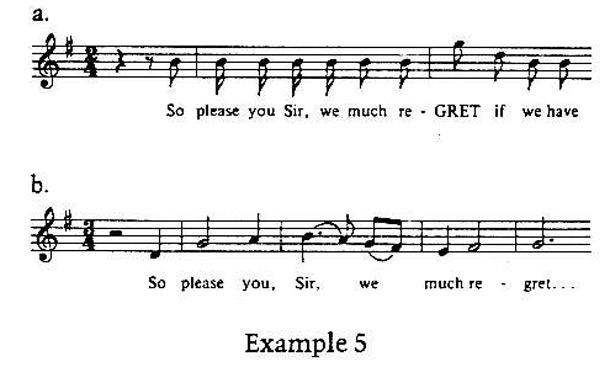
The striking use of sprung declamation made by Sullivan in the quintet is evident in the first melodic phrase of this vivacious ensemble (ex. 5a). Quite at odds with the bounce and bubble of the final result, Gilbert's lyrics are in squarely regular iambic tetrameter, indistinguishable as versification from a somber meditation like Robert Frost's Stopping by Woods on a Snowy Evening („Whose woods these are I think I know“ ). Sullivan's setting completely ignores the steady iambic beat, which a declamation-minded pedant could translate into a lilting waltz rhythm (ex. 5b). His rhythm eliminates (or „frustrates“ ) all but the last stress, which receives thereby a dramatically memorable accent– the phrase bounces irresistibly (and impudently) off the tongue. A complementary type of sprung declamation (accenting of unstressed syllables) is found at the end of the first stanza's last line, on the words „dance and sing.“ The rhythmic pattern formed provides a link to the refrain („But youth, of course“ mm. 1-53) which begins with the identical, sprung rhythm. Between these two instances of „intensified declamation“ are four lines set in „correct declamation,“ providing a relaxation of tension.20
Contrary to his usual procedure, Sullivan makes no attempt to differentiate the characters of the „Three Little Maids“ who introduce themselves in act I, no. 7. Yum-Yum, Peep-Bo, and Pitti-Sing are more or less interchangeable at this point. In fact, the way Gilbert chooses to begin his lyric seems to imply that their most salient point is their corporate 'three-ness':
three little maids from school are we.
The girls' group identity soon pervades Gilbert's lyric– they become quite obsessed with their number in the fourth and fifth stanzas, as they gleefully count off, up and down:
yum-yum: one little maid is a bride, Yum-Yum –
peep-bo: Two little maids in at-TEN-dance come –
pitti-sing: three little maids is the „ro-tal sum
all: three little maids from school!
yum-yum: From three little maids take one away –
peep-bo: Two little maids re-MAiN, and they –
pitti-sing: won't have to wait very long, they say –
Yet that opening line could as easily be read to give an entirely different semantic hierarchy, emphasizing schoolgirlish youth, flightiness, and general lack of matronly decorum:
Three little maids from school are we.
This reading seems particularly appropriate in light of the very un-Japanese disrespect for elders expressed in the second stanza:
yum-yum: Ev'ry-thing is a source of fun.
peep-bo: Nobody's safe, for we care for none!
pitti-sing: Life is a joke that's just be-GUN!
I have represented by the use of upper-case letters the two possible accentuation patterns for these lines: stressing the first and third feet of the opening line gives one semantic reading, stressing the second and fourth feet, another. In reading the verse aloud, one would vary the suprasegemental stress morpheme – shift the accents – to impose the appropriate semantic hierarchy.
Shifting pairs of accents is a very natural musical process, especially if the music is in duple time (this number is in 2/4): one merely moves the beginning of phrases from the downbeat to the upbeat. Sullivan's setting makes much of up-beat vs. downbeat phrase beginnings: when he wants to emphasize the numeric propensities of Gilbert's lyric (as in stanzas 4 and 5, with their counting games), he starts his setting on the downbeat (ex. 6a). Otherwise (in the stanzas that emphasize the three girls' mischievous characters) he starts on the upbeat (ex. 6b). In switching from upbeat to downbeat phrasing, Sullivan systematically manipulates the supra-segmental stress morpheme to favor one semantic interpretation over another, much as one might do in speech. That this is a basic feature of Sullivan's compositional process is shown by the „Essays in Rhythm“ introduced above (plate 1). The poetic stanza Sullivan chose for demonstration was:
Were I thy bride,
Then all the world beside
Were not too wide
To hold my wealth of love Were I thy bride!
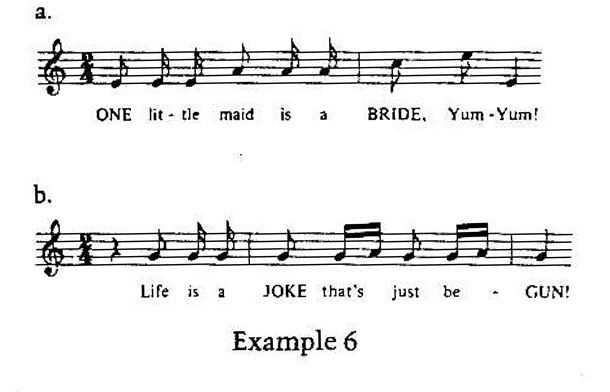
By changing the meter and the starting point of the phrase within the measure, he creates eight settings, no two of which accent the same words in exactly the same way. In the first three essays, Sullivan explores the possibilities of a predominantly eighth-note pulse in common time– by varying the number and disposition of upbeats, he is able to control precisely which syllable receives the first strong accent:
essay no. 1
(4/4, seven upbeat eighths; long note for „bride“ ):
Were I thy bride, then ALL the world beside were NOT...
essay no. 2 (4/4, one upbeat eighth; no long note):
Were I thy bride then all the world be-siDE ...
essay no. 3 (4/4, three upbeat eighths; long note for „bride“ ):
Were I thy BRIDE, then all the world be-siDE ...
Sullivan now tries out the effect of one and three upbeat eighths in triple time, seeing if the lew meter will produce more interesting accen-;uation further down the poetic line:
Essay no. 4 (3/4, one upbeat eighth; long note for 'bride“ ):
Were I thy bride, then all the world beside were not .. .
essay no. 5 (3/4, three upbeat eighths; long note for „bride“ ):
Were I thy BRIDE, then all the world . . .
The composer's explorations begin to coalesce around a setting of „Were I thy bride“ as three eighth notes followed by a dotted quarter, the whole six eighth-note complex systematically shifted around the downbeats of both duple and triple meter measures (only essay no. 2 does not fit this schema). His next step, in essay no. 6, is to investigate the „six-ness“ of his opening gesture, recast in 6/8 – and to break it off („no good“ ). Finally, essay no. 7 is the kind of solution one might expect to see first– a slavish translation of Gilbert's iambic rhythm into a Jig:
essay no. 6 (6/8, three upbeat eighths):
were I thy BRIDE, then all the world be-siDE ...
essay no. 7 (6/8, one upbeat):
Were I thy bride then all the world be-siDE were not too wide . . .
One would like to trace a developmental process in Sullivan's rhythmic variations which leads to the final setting, but his demonstration provides none– Sullivan spoke truthfully when he called five out of six of his solutions commonplace. His first five essays attempt bravely to wring something fresh out of what, in our earlier formulation, would be a cliched example of „correct declamation“ ; nos. 6 and 7 do break away from the overly respectful triple-up-beat pattern, but only to fall into a banal 6/8 lilt. At this point Sullivan relents and gives the actual setting of the lyric used in The Yeoman of the Guard:
essay no. 8 (actual setting; 2/4, one upbeat):
Were I THY BRIDE, then all the world be-siDE . . .
This treatment stands out from Sullivan's „commonplace“ solutions for its elegant use of sprung declamation. His other essays play exhaustively with the possibility of accenting either the second („I“ ) or fourth („bride“ ) syllable of Gilbert's line, in docile accordance with the prevailing iambs, but his final setting largely disregards the meter. By elongating the triple-eighth upbeat into an upbeat eighth plus two stressed quarters, Sullivan imposes a spondaic pattern that conflicts intensely with the poetic meter (what poet would think to accent the unstressed and syntactically weak word „thy“ ?); the resulting complex interaction of word and music rhythms proves so successful that Sullivan reuses it unchanged when the words reappear at the end of this stanza. Each essay's unique combination of stresses – whatever its individual merits vis-a-vis the poem – gives a slightly different semantic tinge to the words; Sullivan chose the one that pleased him most. In this case, the dramatic situation (pretty Phoebe Meryll is attempting to bemuse and distract Wilfred Shadbolt, the assistant jailer of London Tower, so she can steal his keys) justifies a slight overemphasis on „thy“ ; from the point of view of the song's auditor on stage, that is the most important word! As a rhythmic whole, Sullivan's setting is very witty in this respect: between the distinctive sprung declamation at the beginning and end of each stanza („Were I Thy bride“ ) the melody moves in steady, undifferentiated eighth notes, another type of sprung declamation which actually renders Phoebe's highly literary blandishments less intelligible:
The melancholy lute were night-owl's hoot to my low whisper'd coo.
Sullivan makes us hear this seductive song from Wilfred's point of view. We are lulled by the steady patter of syllables and do not pay much attention to their exotic semantic cargo – what we do hear is what he hears: the repetitions of Phoebe's crucial subjunctive promise, „Were I thy bride.„
In a very real sense, these „Essays in Rhythm“ are essays in manipulating musical morphemes, providing a rare first-hand understanding of how, for Sullivan, Gilbert's words were the catalyst for the generation of rhythmic ideas. But the vocal lines thus constructed do not function in isolation. Often, the composer will go a step further and develop his text-derived ideas into wider-ranging musical structures.21
Another pass through „Three Little Maids,' considering this time the way in which the rhythms of the vocal lines interact with their orchestral background, will demonstrate the complex and witty rhythmic processes Sullivan was able to construct. We have seen how the rhythmic cell migrates from upbeat to downbeat in order to bring out semantic nuances of the text; the upbeat/downbeat conflict also participates in a musical structure whose evolution strays far from the poetic – and yet continues to influence our interpretation of the text. The trio starts with downbeat phrasing in the orchestra, which we accept as the norm. The voice parts begin with contradictory upbeat phrasing, apparently entering one beat too late .The rhythmic dissonance thus created demands resolution. This resolution occurs audibly at mm. 16-17, as the ladies slide back onto the downbeat, extending the key word „glee“ into the giddy upward swoop of a major sixth (ex. 7a). Sullivan's rhythmic displacements are now functioning on two levels. Phrases that start or the upbeat produce the pattern of accents which enforce a „flighty“ reading of the text (Three little maids from school are we); at the same time by making the return to downbeat phrasing an audibly humorous event, Sullivan makes th( weak beat phrase beginnings themselves sound flighty and unstable. Musical rhythm is simultaneously creating and reflecting textual meaning.
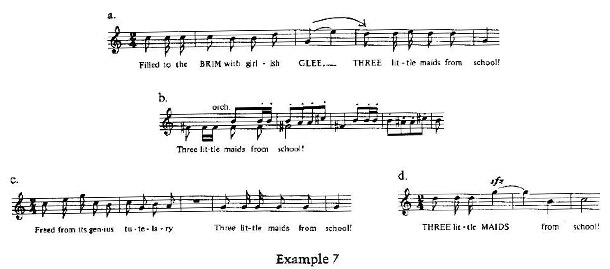
In the next stanza, rhythmic instability becomes endemic. Both orchestra and singers enter on the upbeats until m. 31, where the trio of soloists jumps back onto the downbeat. The orchestra, however, perseveres with upbeat phrasing (and a surprise modulation into the extremely remote key of B major), causing a striking rhythmic overlap at mm. 31-32.22 Measures 31-35 are exceedingly odd: try as one might, the ear cannot help but hear the orchestra's statement of the opening melodic line as rhythmically „wrong,“ and thus even more unstable – truly offbea t– than that tune's original appearance (ex. 7b). This mischievous rhythmic clash is the musically logical consequence of phrasing both with and against the prevailing meter. It is also a perfect musical reaction to a stanza of impudence from Gilbert's giggling schoolgirls.
Finally, at m. 36 all parts are united in downbeat phrasing for the first time, and the harmony veers abruptly back to the tonic C major; this double resolution – harmonic and rhythmic – gives the beginning of the „refrain“ (stanza 3) a strong recapitulatory character. The end of the refrain contains Sullivan's masterstroke: the complete bar of silence at m. 42 (repeated at m. 79). This stanza has adhered rigidly to stable downbeat phrasing; the three maids, on the other hand, have become more and more boisterous as they exult in freedom from their (presumably restrictive) „ladies' seminary“ (mm. 40-41). Previous play leads us to wonder whether this next statement of „Three Little Maids from School“ will begin decorously on the downbeat of m. 42 or more rowdily on the next upbeat. The one thing we do not expect is to have to wait until the downbeat of m. 43 (ex. 7c). The one beat too late of the opening has now been expanded to two beats; two empty beats of breathing space in which to settle down for good into „suddenly demure“ downbeat phrasing.23 Or so we think: there is still one variation left to ring on Sullivan's tiny rhythmic cell. The last statement of „Three Little Maids from School“ at m. 45 begins on the downbeat, as did its predecessor at m. 43; quite unexpectedly, however, Sullivan places both a dynamic and an agogic accent on the word „maids,“ which falls on the normally unstressed second beat (ex. 7d). For the first and only time, the rigid pairing of poetic stresses (1-3 or 2-4) breaks down, and we have a musical phrase which accents both the first poetic stress (as in downbeat phrasing) and the second (as in upbeat phrasing). With this instance of slightly sprung declamation (heavily accenting both „three“ and „maids“ contradicts the normal „hypermetric“ accentuation of Gilbert's four-stress poetic line) the conflict between upbeat and downbeat positioning of Sullivan's rhythmic motive is both heightened and finally resolved – from this point on, as Gilbert's text demands, all the stanzas employ downbeat phrasing.
I find this rhythmic structure quite compelling, especially insofar as it accounts for the empty mm. 42 and 79. Those who require more convincing might ponder Sullivan's sketches for this trio (plate 2). Even a cursory examination of these sketches shows Sullivan working out quite deliberately both upbeat and downbeat versions of various crucial measures. At the spot that I have marked 1, we see Sullivan, after writing out a truncated form of the opening 'ritornello,' sketching out the first stanza both on and off the beat, one underneath the other. Between 2a and 2b we see a sketch for a downbeat version of the second stanza, subsequently discarded. At 3a it is clear that Sullivan changed his conception of this second stanza, actually redrawing the bar lines to create an up-beat setting; stanza 2 is sketched out again near the bottom of the page, at 3b. Examination of the spot designated 4a reveals that at this point Sullivan sketched out the end of stanza 2 without the crucial collision at m. 31; 4b shows the overlapping stemming from the earlier, downbeat phrased version of stanza 2, the end of which was eventually grafted onto the upbeat version to create the overlap, and 5a and 5b point out the sketches for stanza 3. Notice that the critical empty measure is part of the original conception.24 Finally, the spots marked 6a and 6b are the sketches for stanzas 4 and 5, which underwent little significant change from sketch to score.25 The documentary evidence is clear and unequivocal: that the rhythmic issues discussed above were definitely a part of Sullivan's original compositional conception.
V
I would like to touch briefly on two other aspects of rhythmic structure: first, the organic (and often hidden) relationship between the instrumental introductions of Sullivan's songs and the rhythms of the melodies themselves. The relation between melody and introduce is rarely one of pitch; rather, the link is a rhythmic cell contained in the melody, used either unchanged or transformed in some way.
One of the clearest instances appears in act no. 2 of Mikado, where the first melodic gesture of Sullivan's introduction provides a kind pre-echo of the composer's rhythmic response to the text. Here are the first two stanzas of Gilbert's lyric, which Sullivan sets as the first strophe of a three-strophe song:
Our great Mikado, virtuous man,
When he to rule our land began,
Resolved to try a plan whereby
Young men might best be steadied
So he decreed in words succinct
That all who flirted, leered, or winked
Unless connubially linked
Should forthwith be beheaded!
Gilbert, as so often, has cast his poetry in absolutely regular iambic tetrameter; Sullivan, typically, undermines the poetic meter with ruthless thoroughness. Ignoring internal rhymes and suppressing line breaks, he sets the entirety of both stanzas in two sinuously unbroken streams of eighth notes– a most extreme version of the sprung declamation in „Were I Thy Bride“ . The procedure has a similar effect here: the words run together, shifting all the speech-tension energy of these long strings of phonemes to the last words of each stanza, whose feminine endings receive a walloping thump (ex. 8a). The crucial word of the entire lyric– beheaded– is set in high relief. Its three-note setting (bracketed as x) is so overstressed by pent-up tension that Sullivan has to repeat it and let the phrase flower into a long melisma before the energy is run to ground (ex. 8b). The last three notes of this melisma (bracketed as y) are a simple transformation of the „behead figure marked x; it is this more emphatic version which appears as the rhythm of m. 1 (ex. 8c). The introduction bears no pitch relation to the motivic material of what follows, but its distinctive opening rhythm stands almost as a symbol, anticipating wordlessly the endpoint of Sullivan's text-based rhythmic strategy.26
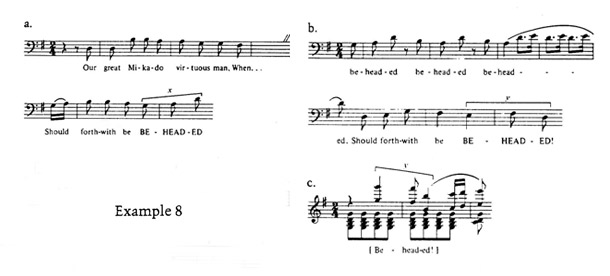
Plate 2: Original sketch of the score of „Three Little Maids from School.„
On a larger scale, Sullivan is remarkably sensitive to the long-range constructive possibilities of Dahlhaus's „strokes and rebounds.“ Often he uses repetition and transformation of simple rhythmic units to structure long passages of music that are only loosely related harmonically and motivically; the act I finale of The Mikado is particularly noteworthy in this connection. An important unifying link for this finale is the „triple upbeat“ rhythm used obsessively in the first choral entrance (ex. 9). Examples 9b and c display the various transformations of this rhythmic pattern that occur in the first part of the finale, before Katisha's dramatic entrance. Immediately after her appearance, she and the chorus continue with triple-upbeat patterns (see ex. 9d); her intense solo, however, is saturated with a new, distinctive rhythm (ex. 10). By its newness, and Sullivan's insistence on it, this contrasting rhythmic cell takes on the function of a Leitmotiv, powerfully associated with Katisha (the fact that Sullivan chose this particular cell can be explained by the theories of text-music correspondence described above) Sullivan now uses his rhythmic Leitmotiv for a witty and dramatic effect. Pitti-Sing (the most impudent of the three little maids) steps out of the chorus and replies to Katisha's outburst in mock-serious style. The beginning of her line takes over Katisha's rhythm exactly. Soon, however, she reverts to her schoolgirl frivolity and begins to make fun of Katisha, in jaunty 6/8 time (ex. 11). The two-note tag at the end of this phrase is Katisha's rhythm, softened into triple time; thus we hear Pitti-Sing's solo as a mocking transformation of Katisha's (it helps that the two opening phrases have the same 5-3-1 melodic shape). This technique can be found in Wagner: the relation of Siegfried's jaunty horn call in Siegfried to the majestic transformation of it used as his Leitmotiv in Götterdämmerung is exactly the reverse of the one just described.
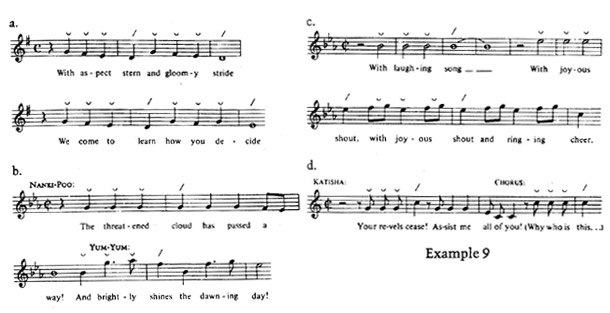
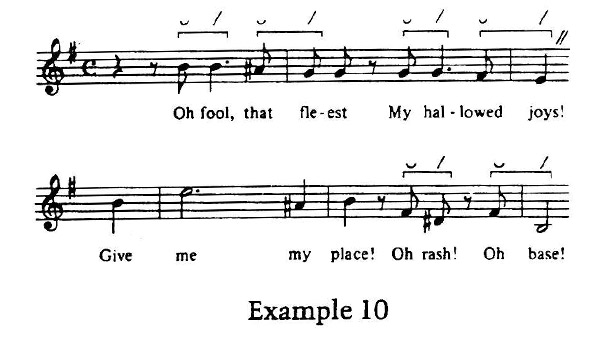
After this „rhythmic modulation,“ Sullivan provides his act I finale with a large-scale unity by returning to the original rhythmic pattern at the end. The final tune of this finale is built from a continuous stream of three-note upbeats (ex. 12). Consequently, the last part of the finale has a subtle feeling of thematic recapitulation, though it has no real motivic or melodic connection to the opening. Sullivan's rhythmic return reinforces the harmonic closure of the return to G major, the central tonality of the entire finale.
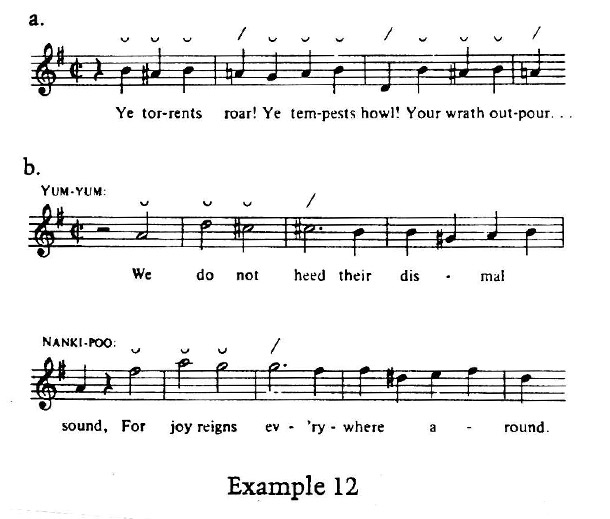
VI
The epigraph at the head of this essay may not, in the final analysis, be so simply apposite as it seems. As we have seen, „good declamation“ – the proper relation of text and music rhythm– is by no means a clear-cut virtue. When faced with Gilbertian lyrics, it is not the adaptable „suppleness“ of Sullivan's rhythm but rather its stubborn resistance to stock poetic meters that creates settings of memorable and lasting worth. It is clear that these texts were a fount of rhythmic ideas for Sullivan – a crucial compositional inspiration. A glance at Haddon Hall, The Emerald Isle, The Rose of Persia (or any of Sullivan's oratorios, for that matter) will show that when incompetent texts bored him, Sullivan could be as bad as Balfe. But Gilbert's poetry, though it „bothered him to death,“ brought Sullivan's music to life; in the comic struggle between the pronounced and rigid rhythms of both light verse and light opera, Sullivan maintained a fluid synthesis that was unprecedented in England. He achieved a music that was independent but not ignorant of the subtle rhythms of poetic speech – a song that was supple without being supine.
As I hope this essay has shown, the music of Sir Arthur Sullivan amply repays serious analytical and documentary study, and the field is wide open. In November 1989 the Pierpont Morgan Library sponsored a conference titled „Gilbert and Sullivan: A Window on the Victorian World.“ Papers on Gilbert by theater historians outnumbered papers on Sullivan by more than two to one; none of the papers that actually mentioned Sullivan promised any real engagement with his music. Paradoxically, the literature on Gilbert and Sullivan is at the same time vast and – to the scholarly eye – mostly worthless. One can count on one hand the studies of serious musicological value: biographies by Percy Young and Arthur Jacobs; pioneering bibliographic and documentary work by Reginald Alien at the Pierpont Morgan Library; an autograph facsimile of Mikado; and one slim volume of stylistic analysis– now thirty years old – by Gervase Hughes. Thanks to their jealous guarding by the D'Oyly Carte family, full scores of the Gilbert and Sullivan operettas were not even available until about fifteen years ago; the only reason some are now in print is the industrious publication for amateur use of pirated editions – editions which of course are terrifyingly corrupt.27 On the other hand, the continued survival of the D'Oyly Carte company has made copious materials available for historical reconstruction. We have recordings going back to the early years of the century, Gilbert's prompt books, and exhaustive visual records of every original production, in addition to memoirs filled with performance recollei tions from almost every member of the origin, Savoy Opera company, including Sullivan musical director and chief amanuensis, Francois Cellier.
Still, while pleas for decent editions and prospects for recapturing a historically significant theatrical style might be met with scholarly interest, serious musical analysis of operettas remains an eccentric pursuit. Yet it is hardly necessary to eliminate value judgement merely to give Sullivan his due; in support, I offer this valedictory observation, which has an appropriately Gilbertian air of paradox. There were in the nineteenth century two operatic oeuvres so characteristic and compelling that the spawned permanent theatrical companies dedicated to performing only those works, quasi-national repertory companies that have survived undiversified to this very day. The music-dramas of Richard Wagner formed one such oeuvre the other, vastly different in all but success, encompassed the comic operas of Gilbert and Sullivan. Between Bayreuth and the Savoy there is indeed „a great gulf fix't“ – but perhaps it is more a matter of world-view than quality.
© by the Regents of the University of California
Published here with kind permission of the author.
1 Information on Arthur Sullivan's life is taken primarily from the exhaustive Arthur Jacobs, Arthur Sullivan: A Victorian Musician (Oxford, 1984); and Percy Young, Sir Arthur Sullivan (London, 1971).
2 See Jacobs, Arthur Sullivan, p. 11.
3 Even the arrangement of vocal parts contributes to the effect: Sullivan's ensemble of two women and three men occupies the same vocal ranges as the typical five-part male voice glee, thus:
Pitti-Sing (alto) = Countertenor
Katisha (alto) = Tenor I
Ko-Ko (light baritone) = Tenor n
Poo-Bah (baritone) = Bass I
Mikado (bass) = Bass n
The effect, when performed with the proper solemnity, is irresistible.
4 From an 1878 review of The Sorcerer which appeared in the London Figaro; quoted in Jacobs, Arthur Sullivan, p. 112.
5 Even when they worked with Gilbert: Clay and Gilbert collaborated on a chamber operetta for the German Reeds' „Gallery of Illustration,“ Ages Ago (1869), and Cellier was the composer who was willing to set Gilbert's notorious „lozenge plot“ libretto, The Mountebanks (1892), during the librettist's feud with Sullivan.
6 Young, Sullivan, p. 261, n. 5.
7 The following discussion is greatly indebted to James Anderson Winn, Unsuspected Eloquence (New Haven, 1981).
8 Winn, Unsuspected Eloquence, p. 243.
10 Carl Dahlhaus, Nineteenth-Century Music, trans. J. Bradford Robinson (Berkeley and Los Angeles, 1989), p. 67.
11 Arthur Lawrence, Sir Arthur Sullivan: Life Story, Letters, and Reminiscences (1899; rpt. New York, 1980).
12Lawrence, Sir Arthur Sullivan, pp. 225-26.
14The locus classicus here is „For he is an E-E-E-E-E-E-E-E-Englishman“ from HMS Pinafore, act II; see also Mikado, act I, no. 2, and finale (at Pooh-Bah's words „Long life to you“ ).
15 Martin Lange, „Begegnung von Sprache und Musik – Dargestellt am Beispiel einer Schütz-Motette,“ in Bachstunden: Festschrift fur Helmut Walcha zum 70. Gebut-stag, ed. Walther Dennhard and Gottlob Ritter (Frankfurt, 1978), pp. 129-43.
16 New York Mirror, 3 October 1885; quoted in Young, Sir Arthur Sullivan, p. 142.
17 Westergaard, „Sung Language,“ Proceedings of the American Society of University Composers 1 (1967), 9-36.
18 I am assuming here that part of the semantic information carried by a spoken sentence is the state of mind of the person who utters it.
19 Diary entry for 21 December 1884, cited in Jacobs, Arthur Sulhvan, p.199.
20 Notice that it is just here that Sullivan raises the level of harmonic tension with mode mixture and appoggiaturas.
21 A similar procedure is analyzed by Rufus Hallmark anc Ann Clark Fehn, in their article, „Schubert's Setting of Pentameter Poetry,“ Zeitschrift fur Literaturwissenschaft und Linguistik 34 (1979), 80-111. They point out that iambit pentameter, as popular as it is with poets, creates a problerc for the composer of art song. A five-stress line simply cannot be set in even declamation if the music is to retain symmet ric phrasing; it must be shortened (to four measures) or lengthened (to six). Schubert had two standard ways of dealing with this problem: a most characteristic method for hire is the compression of the third and fourth feet into the space of one, giving rise to a characteristic declamational rhythm long long short short long
Hallmark and Fehn go on to demonstrate how this rhythmic pattern, created by the exigencies of text setting, structures the harmonic rhythm of an entire song, Schubert's Der Zwerg, D. 771.
22 Gervase Hughes discusses the shifting accents in this passage in The Music of Arthur Sullivan (London, 1960), pp. 33– 34.
23 A stage direction; see G. Schinner vocal score, p. 71.
24 This bar is empty in the autograph; someone (perhaps Sullivan, perhaps not) has penciled in the bassoon solo that is always played here and at m. 79.
25 The sketch shows, interestingly enough, that the following quartet originally had a completely different (and less rhythmically ingenious) refrain; see the spot marked 7. It also supports Sullivan's claim that he conceived rhythm before melodic shape: note that in the sketches for the quartet's opening, the rhythm is exactly that of the final piece, while the melodic material varies widely from Sullivan's eventual tune.
26 Similar procedures are at work in act I, nos. 7 and 8: in „Three Little Maids“ the rhythmic cell appears in overlapping fashion on both up and downbeats, anticipating the crucial overlap at mm. 31-35; while in „So Please You Sir“ the vitally sprung rhythm of the opening line is moved back by one quarter note with respect to the downbeat to energize the vivacious opening tune. In neither case is there any purely melodic motivic connection.
27 Rumors of a fully completed but unpublished Mikado critical edition do persist; I, for one, am not particularly sanguine about its prospective appearance.